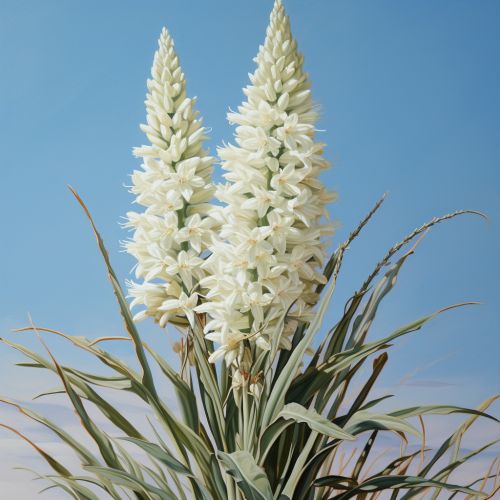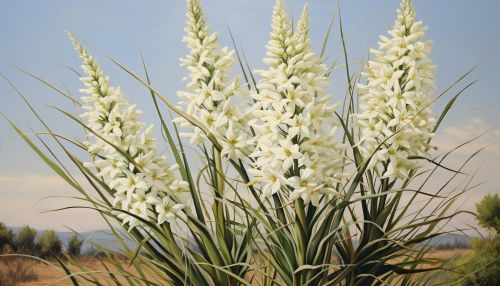Yucca
Overview
The Yucca is a genus of perennial shrubs and trees in the family Asparagaceae, subfamily Agavoideae. Its 40-50 species are notable for their rosettes of evergreen, tough, sword-shaped leaves and large terminal panicles of white or whitish flowers. They are native to the hot and dry (arid) parts of the Americas and the Caribbean.
Description
Yucca species are characterized by their rosettes of tough, sword-shaped leaves. The leaves are generally linear and flat, though some species have leaves that are edged with curly filaments. The leaves vary in color from deep green to blue-green, and can be variegated or striped. The leaf margins are generally sharp, and can be finely toothed or smooth. The leaf tips are often sharp, and some species have a spine at the leaf tip.


Yucca flowers are generally white or cream, and are produced in large, upright clusters. The flowers are bell-shaped and are pollinated by the yucca moth, in a relationship that is beneficial to both plant and insect. The fruit is a large, fleshy capsule that splits open at maturity to release the seeds.
Distribution and habitat
Yuccas are native to the hot and dry parts of the Americas and the Caribbean. They are found from the southeastern United States west to California and north to Alberta in Canada, and south to Guatemala. They are also found in the Caribbean, with species native to Cuba, Hispaniola, and Puerto Rico.
Yuccas are adapted to a wide range of habitats, from coastal sands to mountainous regions. They are particularly common in arid and semi-arid regions, where they are a dominant component of the vegetation. They are also found in grasslands, shrublands, and forests, and can be found at elevations from sea level to over 2,500 meters.
Ecology
Yuccas have a unique relationship with the yucca moth, which acts as the plant's sole pollinator. The female moth collects pollen from the flowers of one plant and transfers it to the flowers of another plant, where she lays her eggs. The larvae feed on the developing seeds, but leave enough seeds for the plant to reproduce. This mutualistic relationship is an example of coevolution, where two species evolve together in response to each other.
Yuccas are also important food plants for a variety of other insects and animals. The flowers are eaten by deer and antelope, and the seeds are eaten by a variety of birds and rodents. The roots of some species are used by Native Americans as a source of soap.
Cultivation and uses
Yuccas are widely cultivated as ornamental plants. They are valued for their striking architectural shape, their low water requirements, and their resistance to pests and diseases. They are often used in xeriscaping, a form of landscaping that reduces the need for irrigation.
Some species of yucca are also used for their fibers, which can be used to make rope, cloth, and paper. The roots of some species are used to make soap, and the flowers and fruit of some species are edible.
